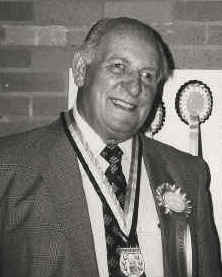
By Alf Ormerod
When I was asked to write this article I was also
given the title but I feel that some of the main points could be missed if I
started off by the youngsters leaving the nest box, so I go briefly back one
step, the reason being that no one wishing to breed exhibition Alsations
would mate the best Alsation to the best Great Dane.
Pairings, must be compatible to give us the right
material to put in the show cage, and no amount of preparation and attention
will make a pet budgie into an Open Show Winner.
By this I don’t mean you have to buy outstanding show
specimens, as even this would not guarantee success, as like doesn’t always
produce like and many of the best birds are not produced from top exhibition
birds from parents with pedigrees. In all livestock it is pedigree that
counts, correctly harnessed so that each parent brings out the hidden best
of it’s partner.
To the Beginners and Novices I would say buy your
birds from a fancier who does well in the Breeder Classes and if possible,
buy matched pairs as recommended by the breeder as he will show you his
records and pedigrees if you ask him to explain why he has selected these
birds in a pair.
Now to the nest box, hoping the eggs are fertile and
hatch out correctly, and I am certain this is where we start to train our
youngsters to the task before them. Just as a baby, after a few days begins
to know it’s mother and have confidence in her touch and handling, so do our
young budgies, and once they have confidence in human beings, the training
is more or less complete.
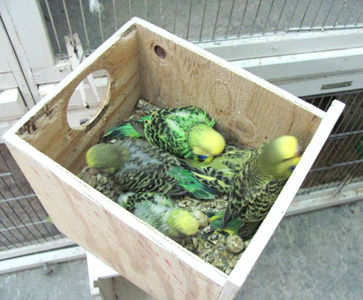
Handle them regularly, at least once a day, checking
that their beaks and feet are clean so that they don’t leave the box with
faulty beaks or deformed feet and be ruined for show, and you will find that
young birds that have been handles often in the nest-box (and the parents
don’t object to this as it has been bred into them) leave the box full of
confidence in human beings and are soon on the perches instead of hiding in
the corners in a heap.
Of course good feeding is essential during these
early days as with humans, and these first six weeks can make all the
difference to a bird’s size and health in later life. Many water additives
are now on the market to supply all the vitamin needs for bone and growth,
but I have always found that what is good for babies is good for budgies,
such as Rose Hip Syrup, ABDEC, Paladac etc., plus cuttle fish bone, old
mortar, good Grit etc, to provide calcium.
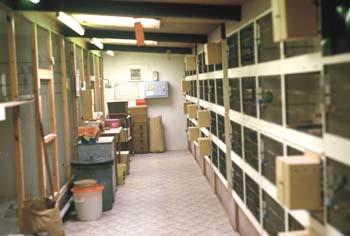
Having left the nest box, don’t be in too big a hurry
to remove the youngsters from their parents and make sure you have seen them
dehusking seed before doing so, as moving them too early can cause big
set-backs, if not losses.
Some people move their young straight to the flights.
I am against this as one doesn’t expect a baby to run before it can walk. I
put the youngsters in a stock cage. Ours are ten feet long with a show cage
fitted at the end. This gives them ample space to exercise their wings and
they go in and out of the show cage at will, and this is the only training
our birds get, as here again I believe that steadiness and showmanship is
bred into them plus the handling whilst in the boxes.
Another reason for putting them in the stock cages is
that you can observe them better as the first week or two with the change
from being fed by their parents to feeding themselves can cause upset
tummies and enteritis. If this occurs and the affected one is not too bad, I
put all that cage on an antibiotic, but if it is very sick and all fluffed
up, take out that bird and put it is a small cage (we use an old show cage
for this purpose) and keep the bird warm with infra-red heat or other
method, and apply medicine to the drinking water not only to that bird but
to all the others in the stock cage it came out of. The one I fend best for
this is Suspension Chloromycetin Palmitate, made by Parke-Davis and
obtainable through a vet or druggist. (This is given to babies). Put ten
drops in a normal size clip-on drinking fountain and shake well to mix. Use
for three days, then replace with a fresh supply for a further three days,
and this should clear the trouble.
We put the youngsters into the large open flight at
10 to 12 weeks old, preferably with a few older birds that have been
pensioned off or not used for breeding. These will show them the way around
to feed pots etc and the way in and out of sleeping quarters.
I prefer earth floors in the flights. This is forked
over each year so that is doesn’t become sour, and a portion has grass turf
on it. These are renewed every Spring. Birds get a lot from the soil such as
minerals, grubs etc, and the grass is also beneficial to them.
Make a habit of checking your birds in the flight
every day, as when so many are flying together a sick bird, and it is always
the best, can be overlooked until it is too late to save it.
I don’t use colored rings for parent identity
purposes, but any young birds that stand out from the rest in nest feather
are rung with a colored ring before being put in the flights and then at
about 4 ½ months old the most promising are caught up for the early shows
and it is generally those that have been rung.
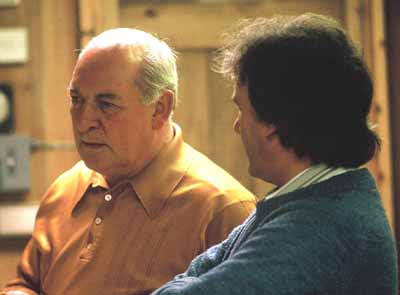
They are put in long stock cages again with show
cages on the end and left for two or three days to settle down. Then they
are put in show cages to be sorted out, but of course from experience one
can tell in the stock cages whether they have made the grade or not; but the
show cage is the final test. I only leave them in the show cage for a short
time at first, then increase the time for those selected for the show team.
But as I said before, showmanship is bred into a bird, but no bird is ever
left in a show cage at home for longer than two hours. If we have a good
specimen that does not appear too happy in a show cage I put an old stager
in with it for a number of times, and this generally does the trick.
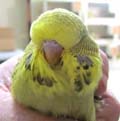
Having selected the young birds that will be the
basis of our early shows I check their wings for any broken flight feathers,
as this can make all the difference between 1st and 2nd,
and these are firmly pulled out in a straight line that will regrow in
approximately six weeks; and the tail feathers, the two long ones are also
removed in the same way as young birds have a nasty habit of dropping all
the tail feathers just as the shows get underway.
Spraying now begins, and this steadies a bird down
more than anything else. For this purpose I prefer a show cage as I never
handle a bird being prepared for a show more than is needed as this takes
away the bloom from the feathers, more so during the Summer weather when our
hands are moist and clammy. They are run from the end of the stock cage into
the spray show cage, and they soon get used to this with a show cage always
being in position.
The first spray is always a light one as they have
been accustomed to being rained on in the open flights and they enjoy it.
Each time the amount is increased so that they get to a stage where after
spraying they look half drowned, but the feathers have now got used to the
spraying so that the birds are really dry by roosting time.
I prefer to spray in the morning and used to do this
before going to work, many a time in half light or darkness during the
Winter months, and the lights were then left on for them until daylight. At
the start they are sprayed two or three times a week, then this is reduced
to one heavy spray per week and a lighter spray the day before the show.
Unwanted spots are removed about five days before the
show, and I talke these out with tweezers, doing this in the cool of the
morning or evening, again because in your hands the birds are cooler and
they get a spray after this has been done, either the same day or the next
day.
If you have a bird with pin feathers in the head
gently stroke them in the direction as they grow with a silk handkerchief or
nylon – this helps to remove the wax casing; or you can use a soft
toothbrush dipped in warm water, especially if there are any bloody quills.
If you have any blood marks on the head or body from
fighting or burst blood quills, put a teaspoon of Stergene in a teacup of
warm water and wipe the affected parts over with the solution with a piece
of cotton wool.
Do this a few times then put the bird back in the
cage to dry. I have often done this at the last minute before boxing the
birds and put the bird straight into the show cage, as it dries before
judging time.
If you have a bird with a cracked flight or tail
feather dip this into boiling water. Use a beaker deep enough for the length
of the tail feather. Fill the beaker with boiling water, then holding the
bird with your finger and thumb at the top of the tail to protect the
private parts, immerse the feathers and you will see the cracked one go
straight again. That happens as you soften the wax in the feather and it
heals the crack. Wipe off surplus water with a handkerchief or soft cloth
and the bird will do the rest.
